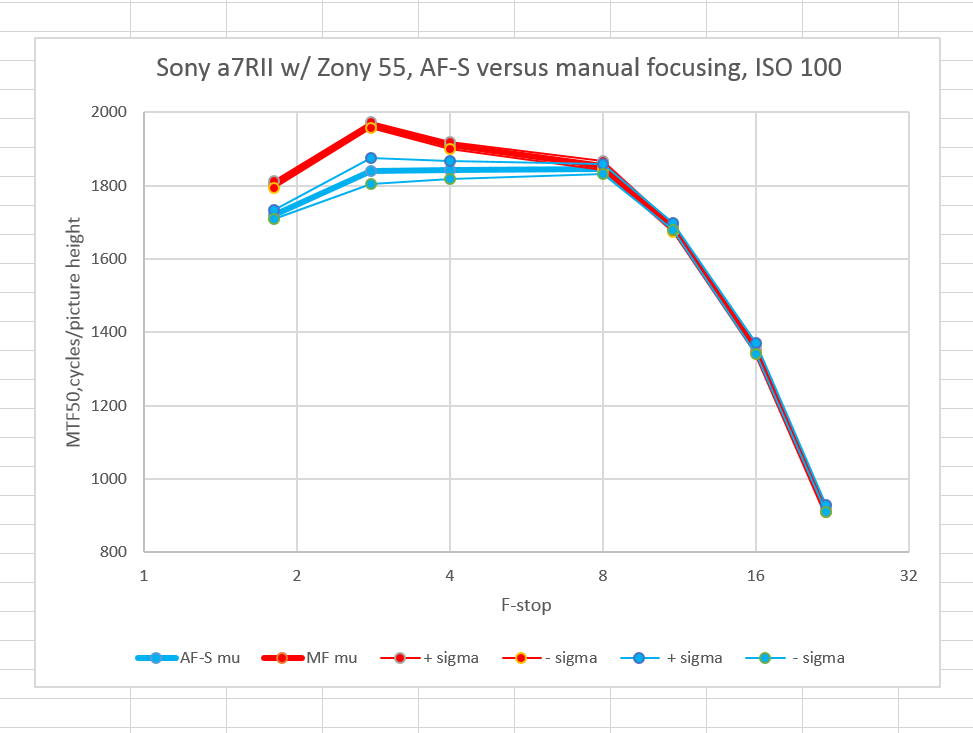A participant in the DPR Photographic Science and Technology forum challenged my — admittedly based on gut feel and experience — contention that, for critical focusing, it was more accurate to do it manually than with autofocus.
I thought about it, and decided that I wanted to see some real data. I took a Sony a7RII and mounted the Zony 55/1.8 FE lens, and clipped the camera to a Arca Swiss Cube that was attached to a meaty set of RRS carbon fiber legs. I aimed the camera at the slanted edge target, set the ISO to 100, the IBIS to off, the EFCS to on, and made an aperture series under Fotodiox 5500 Kelvin illumination with 16 images per data point. I did not moderate the light level or use a neutral density filter; I wanted to simulate what you’d see stopping down the lens in the field.
The light level gave an exposure of 1/1000 second at f/1.8. The AF-S system had no indecisive moments, even at f/22. The manual focusing was done wide open on the Siemens star. The automatic focusing was done at the taking aperture on the same star, using the smallest focusing square. It doesn’t get much easier to focus than this, either manually or automatically. I used an electronic remote release that allowed half-presses to give the autofocus time to do its stuff before I tripped the shutter. To manually focus, I used maximum magnification with the lowest peaking level. I actually could have used a lower peaking level; the star lit up from top to bottom when I was close to critical focus.
The results:
The vertical axis is the MTF50 for the image: the point where, as the spatial frequency of the subject matter increases, the response on the sensor is reduced to half its very-low-frequency value. The units of spatial frequency are cycles per picture height. The horizontal axis is the f-stop.
The heavy lines are the average for all 16 exposures. The red ones pertain to the manually focused images, and the blue to the AF-S ones. The light lines are the average plus one standard deviation and the average minus one standard deviation. If the statistics for handheld MTF50 turn out to be Gaussian, about two thirds of the images will fall between the two narrow lines. Mu stands for mean. and sigma for standard deviation.
I was sort of right. At f/1.8, f/2.8, and f/4, I could focus better than the camera. For the other apertures it was a tie. I didn’t get a set of captures for manual focus at f/5.6, so I left the AF-S points at that aperture off the graph, too.
I expect that the lower than expected results at f/4 for manual focusing are due to focus shift.
I doubt if a DSLR could match these results without a fair amount of tweaking to the autofocus. However, that’s another gut feeling, and I should probably test it.

CarVac says
http://www.lensrentals.com/blog/2012/07/autofocus-reality-part-3a-canon-lenses
Assuming you have the latest lenses with the latest focusing system, Canons seem to have MTFs equivalent to the best you can do with manual focus.
On the other hand, perhaps they should try the same testing again with the 5Ds to be more discerning.
Bill Janes says
Jim,
Excellent work, as usual for you. However, I have a couple of comments. For manual focus, you focus wide open and then stop down to capture the image. Why didn’t you do the same with the autofocus rather than focusing at the taking aperture? The decreased depth of field at wide apertures may also improve focus accuracy with autofocus as well as manual focus.
You comment that focus shift may have compromised the images at f/4, so why not manual focus at f/4? Focus shift may also have degraded the images at apertures smaller than f/4. Diglloyd points that with most fast lenses, focus shift occurs most prominently when stoping down from wide open to f/4 or so, and he recommends that for apertures smaller than f/4, one should focus at f/4.
Regards,
Bill
Jim says
That’s not how AF-S works on the a7x cameras, or so I understand. Maybe someone who knows can weigh in here.
I probably should have done a run that way. I probably should have focused 16 times for each data point. There are lots of things to test. Unfortunately, these tests take a lot of time and effort as it is. And they’re tedious, too.
Jim
Chris Livsey says
What it boils down to is one per cent inspiration and ninety-nine per cent perspiration.
Statement in a press conference (1929), as quoted in Uncommon Friends: Life with Thomas Edison, Henry Ford, Harvey Firestone, Alexis Carrel & Charles Lindbergh (1987) by James D. Newton, p. 24.